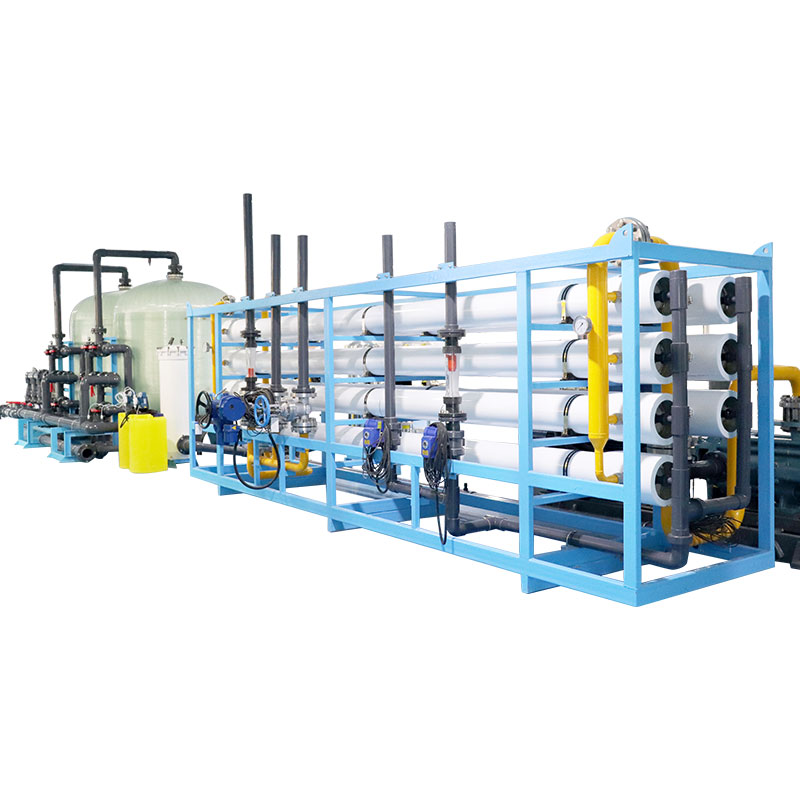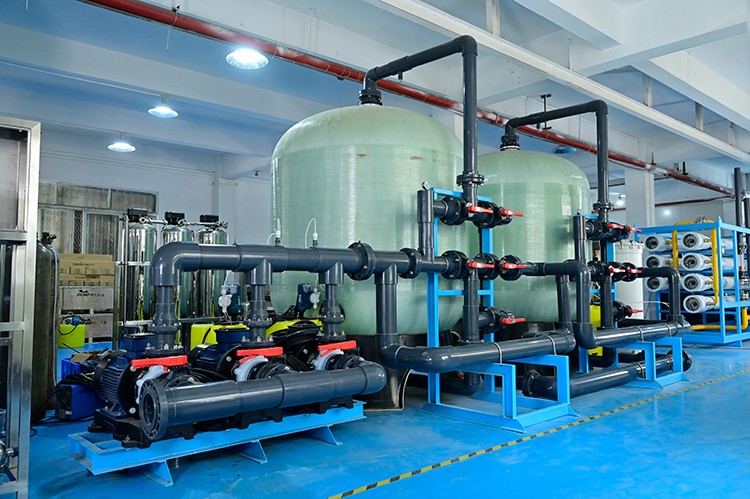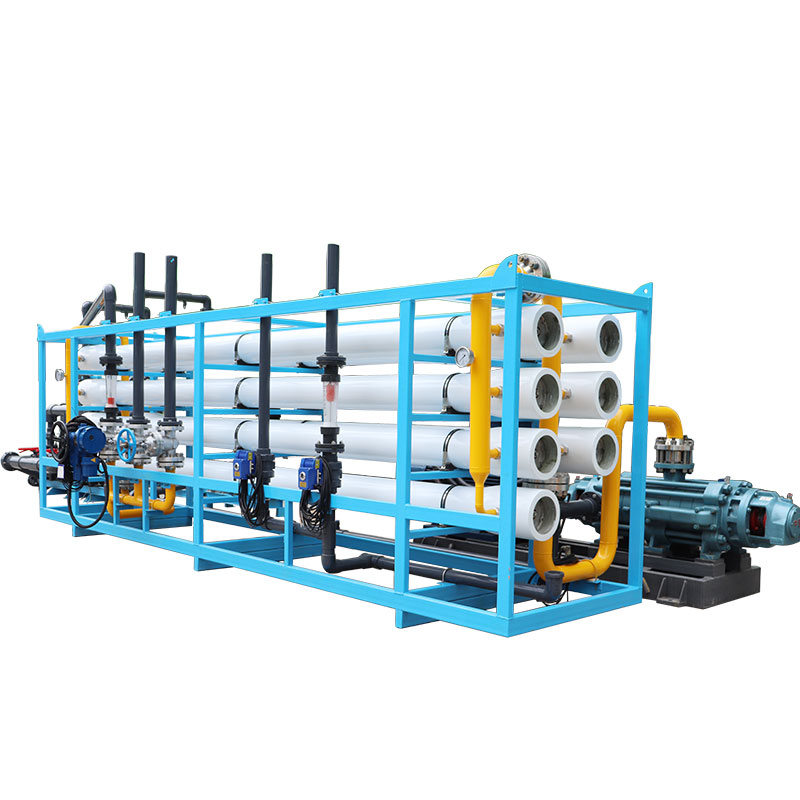Reverse Osmosis Water Treatment Plant vs. Distillation Plant: Are They the Same?
In today's water treatment technology, reverse osmosis (RO) and distillation are two widely used technologies for purifying and desalinating water. These two technologies are widely used in different scenarios, but their working principles and application scenarios are very different.
So, does reverse osmosis work the same as distillation? Are reverse osmosis water treatment plants the same as distillations? This article will explore these questions in depth.

How does reverse osmosis work?
Reverse osmosis is a water treatment technology based on physical isolation. Its core principle is to use a semipermeable membrane to separate soluble impurities in water. Specifically, reverse osmosis applies pressure to allow water molecules to pass through a special semipermeable membrane, while impurities are retained on the other side of the membrane, thereby purifying or desalinating water.
Structure and function of semipermeable membrane
The semipermeable membrane is the core component of the reverse osmosis system. Its pore size is very small, usually at the nanometer level, allowing only water molecules to pass through, while other larger molecules such as salt ions, organic matter and microorganisms are blocked outside the membrane. This selective permeability makes reverse osmosis an extremely effective water purification technology.
The role of pressure
In the reverse osmosis process, pressure acts as a driving force. In nature, water always permeates from areas of low solute concentration to areas of high solute concentration, which is a natural osmosis phenomenon. Reverse osmosis reverses this natural process by applying external pressure, causing water to permeate from areas of high solute concentration (such as salt water) to areas of low solute concentration (such as fresh water). The applied pressure must be large enough to overcome the osmotic pressure of the solution, usually several times higher than the osmotic pressure of the solution, so that effective water purification can be achieved.
Application scenarios of reverse osmosis
Reverse osmosis technology is widely used in seawater desalination, industrial wastewater treatment, drinking water purification and other fields. Its efficient separation ability enables it to remove most pollutants in water, including salt, heavy metals, bacteria and viruses.
How does distillation work?
Distillation is a water treatment technology based on phase change. Its core principle is to use the evaporation and condensation process of water to separate impurities in water. Distillation usually involves two main steps: first, water is heated to boiling point, evaporating it into water vapor; then the water vapor is condensed back into liquid, leaving impurities in the raw water, thereby purifying the water.
Phase change process
The key to distillation lies in the phase change process of water. When water is heated to boiling point, water molecules change from liquid to gaseous state and become water vapor. In this process, most soluble impurities in water, such as salts and organic matter, remain in the raw water because they are not easy to volatilize. The water vapor is then cooled and condensed into pure liquid water.
Energy consumption
The distillation process requires a lot of energy to heat the water and condense it. Therefore, although distillation technology can produce extremely pure water, its high energy consumption limits its use in large-scale applications, especially in areas with limited resources or high energy costs.
Application scenarios of distillation
Distillation technology is often used in scenarios where high-purity water is required, such as pharmaceuticals, laboratory research, and special industrial production. In addition, in some remote areas where reverse osmosis technology cannot be used, distillation is still an effective means of water purification.

Reverse Osmosis vs. Distillation
Although both reverse osmosis and distillation are water purification technologies, their working principles and application scenarios are significantly different. The following are the main differences between the two:
Differences in working principles
● Reverse osmosis relies on physical separation, separating water molecules under pressure through a semipermeable membrane.
● Distillation is based on phase change, separating impurities in water through heating and condensation processes.
Energy consumption
● Reverse osmosis is mainly driven by pressure, and the energy consumption is relatively low. Especially in the context of modern technological advances, the energy efficiency of reverse osmosis systems has been significantly improved.
● Distillation requires a lot of heat energy to achieve water evaporation and condensation, which has high energy consumption and is relatively expensive.
Water purity
● Reverse osmosis can remove most soluble impurities, but may not be as effective as distillation in removing volatile organic compounds (VOCs) and some small molecular compounds.
● Distillation can remove almost all non-volatile substances, so the water purity is very high, which is suitable for occasions with extremely high water quality requirements.
Equipment complexity and maintenance
● The reverse osmosis system involves equipment such as pumps, pressure vessels and membrane components, and the maintenance is relatively complex, especially the cleaning and replacement of the membrane is a key maintenance link.
● The distillation system has a relatively simple structure, mainly composed of heaters and condensers, but its long-term operation needs to prevent scaling and corrosion problems.
Processing speed
● The reverse osmosis system usually processes water at a fast speed and can process a large amount of water in a short time, which is suitable for large-scale water treatment needs.
● The distillation system has a relatively slow processing speed, especially when processing large-scale water volumes, the efficiency of distillation is limited by the heating and cooling capacity.

Reverse Osmosis Water Treatment Plant vs. Distillation Plant: Are They the Same?
Due to the different working principles and application scenarios of reverse osmosis and distillation, there are also significant differences in the design, operation and maintenance of reverse osmosis water treatment plants and distillation plants.
Plant structure and design
● Reverse osmosis water treatment plant: usually includes multiple reverse osmosis membrane modules, booster pumps, pretreatment devices (such as sand filters, activated carbon filters) and chemical dosing systems. The entire system is connected by pipes and control systems to achieve water filtration, purification and distribution. Reverse osmosis water treatment plants are usually compact in design and suitable for treating large-scale water volumes.
● Distillery: The design structure is relatively simple, mainly consisting of evaporators, condensers, heat exchangers and water storage tanks. The core of the distillery is the heating and cooling system, and its design needs to consider the effective use of thermal energy and the efficiency of the condensation process. Since distillation requires a large supply of thermal energy, distilleries usually have special boilers or heat source equipment.
Operating costs
● The operating costs of reverse osmosis water treatment plants are mainly concentrated on power consumption (driving pumps) and membrane replacement and maintenance. Due to the advancement of modern reverse osmosis technology, energy consumption has been greatly reduced, making reverse osmosis water treatment plants cost-effective in large-scale production.
● The operating costs of distilleries are mainly concentrated on thermal energy consumption and equipment maintenance. Due to the high energy required to heat water, the operating costs of distilleries are often higher than those of reverse osmosis plants. In addition, the anti-corrosion and anti-scaling maintenance costs of distillation equipment are also relatively high.
Scope of application
● Reverse osmosis water treatment plants are usually used for large-scale water treatment, such as urban water supply, industrial water treatment and seawater desalination. Reverse osmosis technology can efficiently remove salt, heavy metals and other pollutants from water, and is currently one of the most widely used water treatment technologies.
● Distilleries are mostly used in situations where extremely high purity water is required, such as laboratories, high-purity industrial production and the pharmaceutical industry. Due to the extremely high purity of distilled water, it is also often used for drinking water supply in special environments, such as submarines and space capsules.
Environmental impact
● The wastewater from reverse osmosis water treatment plants is mainly concentrated water, which contains high salt and impurities. How to deal with this wastewater is an environmental challenge, especially in coastal areas, where large amounts of concentrated water discharge may affect the marine ecology.
● The amount of wastewater from a distillery is relatively small, but its high energy consumption means a large demand for energy resources. If non-renewable energy is used, the carbon footprint of a distillery may be higher, so in terms of environmental protection, the energy efficiency of a distillery is crucial.

Conclusion
As two completely different water treatment technologies, reverse osmosis and distillation each have unique advantages and applicable scenarios. Reverse osmosis is widely used in large-scale water treatment projects due to its high efficiency and low energy consumption, while distillation has become an indispensable water treatment method in specific fields due to its excellent water purification ability.
Reverse osmosis water treatment plants and distillation plants have their own advantages in design, operation and maintenance, but their common goal is to provide clean and safe drinking water for humans. Understanding the differences between these two technologies will help us choose the most appropriate water treatment method in practical applications to meet the water treatment challenges under different environments and needs.




